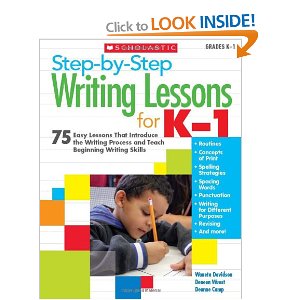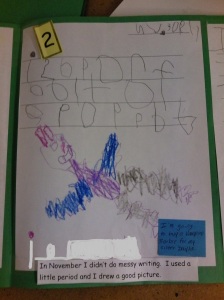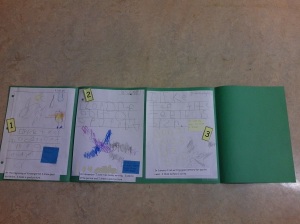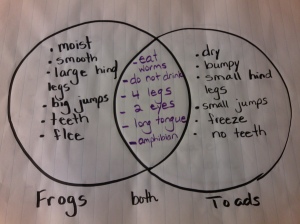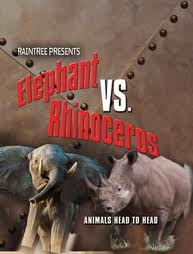I translated this bookmark from an English bookmark I saw a few months ago. I wish I could credit the teacher who made the original. Teaching students how to use a bookmark really helps them to learn how to care for books . I like to change bookmarks regularly so that I am always setting new purposes for reading. This bookmark is for decoding.
Once the strategies have been taught it is a very useful tool for silent reading as well as take home reading. Colour copies ( two to a sheet) are worth printing at staples and laminating. The English translation could be on the back for the take home reading .
Remember this is only for the VISIBLE side of reading. Don’t forget that important invisible side-comprehension!!!
People frequently ask me about my opinion on writing in kindergarten.” Is it really possible?” I say If you believe in them-they will!!!
When I think of the two kindergarten classrooms in my school, I know it is true. Both teachers teach writing with excitement and treat it as a fun part of the day. The children view themselves as writers. The teachers use a combination of PWIM strategies, Daily 5 and incorporate a writing continuum into their daily writing. I am so lucky to work with and learn from such inspiring teachers. Thank you MF and KS 🙂
They also use this book which recommends all kinds of mentor texts for helping young children with writing Step-by-Step Writing Lessons for K-1 by Davidson,Wuest and Camp
The children are proud to show off their writing and talk about the progress they have made. They use their class writing continuum to see where they are and where they need to go next to improve. The continuum is posted where it is easily accessible to them. As the year progresses additional levels are added to the continuum.
Each child has an “accordion” of their year’s writing. They are able to see and talk about their progress. It is shared with parents and the children have their own personal continuum. Their comments about their own writing are scribed for them.
I think my belief in kindergarten writing comes down to this-it is up to the teacher
Talk aloud for writing
Text Structure –Compare Contrast writing
This lesson will be taught over several days!! Thanks Mrs. B for working with me again and sharing your kids 🙂
Introduce lesson“We are going to learn about a text structure authors sometimes use called compare contrast writing. Authors use this structure to show how two things can be alike, yet different. It is an important structure to learn because it will help you to be a better writer but it will also help you to better understand non-fiction or informational text written in this way as well. Some of the key words I want you to listen for are: (posted during lesson)
- alike
- similar but different
- all
- most
- both
- yet
- while
- many
I was reading All About Frogs by Jim Arnosky
and Frogs and Toads by Bobbie Kalman.
I really liked the way both authors helped me to understand how frogs and toads can be similar but they are also different. Many people do not understand the differences. Through the drawings, photographs and compare contrast writing, I was easily able to understand. Listen to what they had to say;
All About Frogs by Jim Arnosky page 4 (ish no page numbers)
Frogs and Toads by Bobbie Kalman page 7
After reading these two passages I made myself a Venn diagram to help me understand what the author was telling me about frogs and toads. A Venn diagram is a graphic organizer that helps us put our thinking on paper. It clarifies our thinking. Making a Venn diagram when we are writing also helps us to organize our writing. Look at my Venn diagram. (share and read together)
Look at my Venn diagram. (share and read together)
I really liked the way these two authors helped me to understand, so I decided to make an attribute list of the way they wrote to help me write my own paragraph.
I noticed that in All About Frogs , Jim Arnosky started by saying :”Frogs and toads are similar but different animals…” while in Frogs and Toads , Bobbie Kalman starts by saying Frogs and Toads look similar but they are different in some ways…These are two really well known authors and they start their paragraph in almost the same way! That must be a really good way to start a paragraph!
They both used compare contrast signal words to make their writing more interesting and to help me understand. Their titles tell me exactly what I was going to read about. They obviously planned out what they wanted to say beforehand. They ended carefully although I liked Jim Arnosky’s ending better-That’s the way it should be forever. He obviously cares a lot about them!!
This is the list I came up with (have it ready to post for reference)
- Introduction says Similar but different
- Use at least 3 compare contrast signal words (alike ,all, most, both, yet, while, many)
- Title
- Ending
- Venn diagram
- Proper punctuation
I decided I wanted to try writing a compare/ contrast paragraph the way Arnosky and Kalman did. I decided to write about Rhinos and elephants because those are two animals I am interested in. I started by making a Venn Diagram as I read-this is what I learned (fill in together to model how you were thinking as you read)Elephants VS. Rhinoceros (Animals Head to Head )
This is the paragraph I wrote about Elephants and Rhinos. (Read aloud to class-post )
Elephants and Rhinos
Elephants and rhinos are similar but different animals. They are alike because they are huge African herbivores. They are both mammals. Elephants have big ears but rhinos do not. Rhinos can run quite quickly but elephants do not. Elephants like to live together yet rhinos prefer to live alone. There are 5 types of rhinos but only 2 types of elephants. Elephants need to drink everyday while Rhinos only need to drink every four days.
Both the elephant and the Rhino are losing their habitats as cities grow. They are both threatened by poachers who hunt them.
They may have many differences but the threat to their lives is similar. Many people in the world are trying to protect these amazing animals. That’s the way it should be.
Now let’s look at my writing and see if I followed the attribute chart to write my paragraph. (correct together-I put my writing up beside the attribute chart –I write all over my paragraph circling,adding deleting and placing check marks on the attribute chart-in this piece I will ask them what other word I can use instead of but…I hope they will notice that I have but 3 times and find a word to change it up. If they don’t notice ,I will leave it-for now.)
Elephants and Rhinos
Elephants and rhinos are similar but different animals. They are alike because they are huge African herbivores. They are both mammals. Elephants have big ears but rhinos do not. Rhinos can run quite quickly but elephants do not. Elephants like to live together yet rhinos prefer to live alone. There are 5 types of rhinos but only 2 types of elephants. Elephants need to drink everyday while Rhinos only need to drink every four days.
Both the elephant and the Rhino are losing their habitats as cities grow. They are both threatened by poachers who hunt them. They may have many differences but the threat to their lives is similar. Many people in the world are trying to protect these amazing animals. That’s the way it should be.
My next lesson will be to write a class paragraph all together about something familiar to the students using exactly the same process. We will create a Venn diagram with attributes about their teacher and me –how we are similar but different, and turn that thinking into a paragraph. ( Maybe without the illustration ) At this point students often add to our word list. We will correct it together-did we follow our attribute chart??
Other ideas for a first try could be comparing an apple and an orange, a cat and a dog, a carrot and a potato, a motorcycle and a bicycle, fairy tales, types of rocks, two sports, two instruments, artists, their parents…)
After some practice your students are ready to try the process with curricular content. The initial planning takes a while, but so many lessons come out of it. A final assignment for me would be to ask students to try to find a piece of writing ( book, magazine,… where the author is comparing two things. Can we add words to our list? What else did the author do to help you understand?
10 Little Buffalo by Sandra Sanatte
Illustrated by Clayton Peters
Native Reflections 2009
This is a great First Nations counting book. The illustrations are really cool , they look like a cross between Claymation and photographs.The kids love them. I was excited to share it with a grade one class who was studying the buffalo.
This book would really help to bridge the math to literacy as well as Social Studies content.
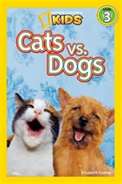 I love this series. This book is great for modeling Compare /Contrast Writing structures. The writing is simple, the text features are clear and the text structure becomes easy to understand. Once students are able to identify the structure in their reading, they will be better able to use it in their own writing and improve their comprehension skills as they read informative text..
I love this series. This book is great for modeling Compare /Contrast Writing structures. The writing is simple, the text features are clear and the text structure becomes easy to understand. Once students are able to identify the structure in their reading, they will be better able to use it in their own writing and improve their comprehension skills as they read informative text..
Some signal words that indicate compare contrast writing are:
- but
- different from
- same as
- similar to
- as opposed to
- instead of
- although
- however
- compared with
- as well as
- both
- while
- such as
- like
I am slowly building my own collection of books to use as mentor text for compare/contrast writing. It is fun to have the children go on a “Treasure Hunt” Looking for the signal words. They write them on sticky notes and after a set amount of time, come back to co-create an anchor chart of the signal words, and share what the author was comparing or contrasting.
Related articles
- Nonfiction Mentor Texts (Dorfman and Cappelli) (mmegc.wordpress.com)


